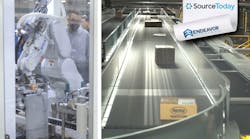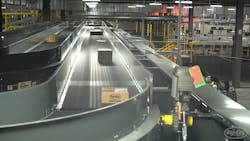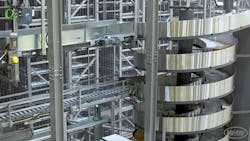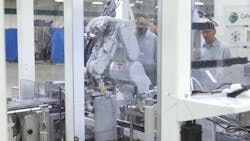This article appeared in Source Today and has been published here with permission.
What you’ll learn:
- How IIoT and AI can alleviate challenges that have impacted the supply chain over the past two years.
- How asset tracking is improving the supply chain.
- Aggregating and analyzing data more quickly with artificial intelligence.
- What’s next for the supply chain.
Advanced technologies like artificial intelligence (AI) and sensors have enabled the supply chain to continually evolve over the past several years, with the goal of keeping operations lean. Less inventory in the pipeline has meant using electronic components and raw materials in the most cost-effective and efficient ways—a huge benefit for many companies. However, when the COVID-19 pandemic took hold and caused global supply-chain disruptions, many industries were left reeling, including the electronics industry.
The industry has experienced an immense bullwhip effect, seeing an initial drop in demand for end-product at the outset of the pandemic, followed by skyrocketing demand for products, alongside a delivery and inventory storage shortage. Unfortunately, this zig-zagging demand in unpredictable places revealed many pain points within the supply chain—primarily, a lack of robustness.
Although efforts to keep the supply chain lean were undertaken with great intentions, the process became so centralized that when even one event affected just one manufacturer, that effect was felt around the world. The supply chain was simply not diverse or robust enough to bring sufficient raw materials into plants, and many were shut down entirely. Labor issues also compounded disruptions, with factory closures and staffing shortages deepening delays throughout the supply chain.
The good news is that AI and IoT sensors have a large part to play in developing a more robust, resilient system, repairing many of the gaps in the supply chain revealed by the pandemic. In fact, the industrial Internet of Things (IIoT) has already impacted the supply chain and manufacturing industry, bringing more predictive, intelligent, and proactive solutions as well as new functionalities that enable enhanced efficiencies.
Enhanced Asset Tracking
One of the many ways IIoT sensors are increasingly being used in the supply chain is for asset tracking. Monitoring the location and status of assets used to be opaque. Today, thanks to the widespread use and lowered price of entry of sensors, customers can access data about their assets in real-time, at any given time.
For instance, with IIoT trackers, a customer could see if their container is still on a ship at a port, or if it’s arrived and is en route to its final destination. That said, knowing the location and status of just one certain asset isn’t enough if it takes, for example, 20 or more components, to produce a product.
This underscores why it’s so important to bring in a unified view of all data coming in from sensors for each of its different inputs, such as components, raw materials, and other products. It’s crucial to aggregate all of this data so that it’s more meaningful and productive for both the customer and consumer who may be tracking their order from home.
Many different sensors are used beyond location tracking as well, to provide more data throughout the supply chain. Environmental sensors that track pressure, temperature, and humidity, and positioning sensors utilizing gyroscopes and accelerometers to track a product’s orientation, position, etc., offer a much more robust view into a product’s journey to its end destination. They also can shed light, for example, into the exact time and place a product may have been damaged.
The widespread application of sensors and trackers is largely due to the reduced cost associated with their use. However, all of the available data from these IIoT powerhouses is only useful when it’s managed properly, analyzed, and acted upon.
Using AI for Data Management
Operations managers need a lot of information to determine if a factory will be able to run production at a certain time, especially with regard to all necessary inputs making it to the plant at the right time. Before IIoT solutions became so widespread, this has traditionally been a bit of a “guessing game” due to the lack of visibility into real-time (and accurate) data.
Now, thanks to IIoT, AI can easily aggregate and analyze the massive amounts of data coming off of sensors to much more accurately predict when all moving parts will be in place. For example, AI systems can use sensor data alongside third-party data, e.g., port feeds and weather information, to proactively predict when the necessary inputs will arrive, as well as if there will be any delays.
A large part of this process also is enabled by edge computing. Data is processed closer to its source or collection point rather than communicating it back to the cloud first, ultimately increasing efficiency.
AI can typically analyze this massive amount of data from disparate sources much faster and more accurately than a human. As a result, workers can spend less of their valuable time on mundane, manual tasks like tracking down locations and statuses of inputs. These intelligent, automated systems free up workers to do more creative, skilled work that requires critical thinking skills, such as managing systems, building relationships with customers, and making difficult judgment calls when needed.
Data-management systems aren’t designed to “replace” workers. Instead, these systems bring to light more meaningful insights to the individual overseeing it. Ultimately, data management through AI unearths new value through improved accuracy and increased efficiency across the board.
Data from Sensors Can Predict Disruptions
IIoT sensors are key to improving operational efficiency and enhancing worker safety, particularly when it comes to enhanced traffic and environmental monitoring. For example, the increasing frequency of wildfires in the U.S. have affected many areas of the supply chain, including creating unsafe driving conditions and closing roads. Companies that incorporate environmental data into their planning, alongside data from asset trackers, were able to shift as needed to account for the disruption.
Weather conditions and traffic jams are often regarded as external factors. However, by bringing them into planning operations, supply-chain professionals can foresee disruptions on the horizon.
What’s Next
IIoT technology is creating loads of new functionality, and a great deal of it is relatively inexpensive to implement, like low-cost processors. From a cost point of view, it’s easier now than ever before to integrate sensors into various products to monitor and collect data, which may not have been financially accessible in the past. Some of these technologies include vision sensors. Such sensors are advancing rapidly, especially when paired with AI to analyze all of the data coming from each pixel in a camera.
The intersection of AI and real-time data, as is the case with many new sensors, has created numerous methods for gaining insight into the supply chain. IIoT will continue to fuel the future of how we work in manufacturing, shipping, and many other areas of the supply chain. These technologies will provide a more holistic view and control over the supply chain, and with any luck will help prevent future disruptions in the global supply.



